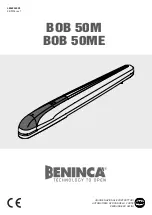
6050-065-C-2-16
32
6.2 Troubleshooting
Have a good VOM meter to check voltages and continuity. A Meg-Ohm meter capable of checking up to 500 meg-ohms of
resistance is necessary to properly check the integrity of the ground loops. When a malfunction occurs, isolate the problem to
one of three areas: 1) the operator, 2) the loop system, 3) the keying devices.
Use caution when checking high voltage areas:
terminals 1 through 6, the motor capacitor and the motor.
Symptom
Possible Solution(s)
•
Check that power to the operator is turned ON.
•
Transformer may be overheated. Turn power off and allow board to cool for several minutes then
retest. Check for low 115 VAC power and low voltage shorts.
•
Check for 115 VAC at terminals 2 and 3. If voltage measures OK, check the terminal strip or
replace the circuit board.
Operator will not run.
Power LED is OFF.
•
Momentarily jumper terminal 11 to terminal 20. If the input LED does not come ON, check the
terminal strip or replace the circuit board. If LED does come ON, proceed to next steps.
•
Check Motor:
-
Momentarily jumper terminal 11 to terminal 20. If the input LED does not come ON, check the
terminal strip or replace the circuit board. If LED does come ON, proceed to next steps.
-
Remove circuit board. With power ON, momentarily jumper terminal 3 to terminal 4 with a
14 AWG insulated jumper wire.
CAUTION – HIGH VOLTAGE.
The motor should run.
-
With power ON, momentarily jumper terminal 3 to terminal 5 with a 14 AWG insulated jumper wire.
CAUTION – HIGH VOLTAGE.
The motor should run in the opposite direction of the above step.
-
If the motor runs in both steps above, replace the control board. If the motor does not run, or runs
in only one direction, problem can be a bad motor, motor capacitor, wire connections from the
control board to the motor or a bad control board.
Operator will not run.
Power LED is ON.
1
. Check the input indicator LEDs. They should only come ON when a keying device (card reader, push button, etc.) is
activated. If any of the input LEDs are ON continuously, this will cause the gate operator to hold open. Disconnect the
keying devices one at a time until the LED goes OFF.
2
. Check any external safety devices. Any short or malfunction in these devices can cause the gate operator to stop or to
hold open.
3
. A malfunction in a loop or loop detector can cause the gate operator to hold open, or to not detect a vehicle when it is
present over the loop. The LEDs next to the loop detector ports on the operator circuit board will light only when the loop
has detected an object above it. If the LEDs stays on after the object has gone, then the loop detector has malfunctioned.
Pull the loop detector circuit boards from the loop ports on the operator circuit board. If the malfunction persists, the
problem is not with the loop system. For more information on trouble shooting loops and loop detectors, refer to your loop
detector instruction sheet and to the DoorKing Loop and Loop Detector Information Manual.
4
. Check to be sure that there are no shorted or open control wires from the keying devices to the gate operator. If a keying
device fails to open the gate, press the key momentarily jumper across terminals 11 and 20 on the gate operator circuit
board. If the gate operator starts, this indicates that a problem exist with the keying device and is not with the gate
operator.
5
. If a three-button control station (open-close-stop) is connected to this gate operator, check for proper wiring. Only a
DoorKing three button control station (P/N 1200-006) can be used with this gate operator. Others will cause a malfunction.
6
. Check the high voltage supply. A voltage drop on the supply line (usually caused by using too small supply voltage
wires) will cause the operator to malfunction. Refer to the wire size chart in section 2.1 on page 16.
•
Check that SW 1, switch 7 is OFF and SW 2, switch 4 is ON.
•
Remove circuit board. Momentarily jumper terminal 3 to one of the secondary motor terminals,
then to the other secondary motor terminal with a 14 AWG insulated jumper wire.
CAUTION – HIGH VOLTAGE. The secondary motor should run one way, then the other way as
power is applied to each terminal.
•
If the secondary motor runs in both directions, replace the control board. If secondary motor does
not run, or runs in only one direction, problem can be in the wiring from the primary to secondary
operator, bad secondary motor or motor capacitor.
Secondary operator
motor will not run.
Continued on next page
Содержание 6050-080
Страница 41: ...6050 065 C 2 16 37...







































